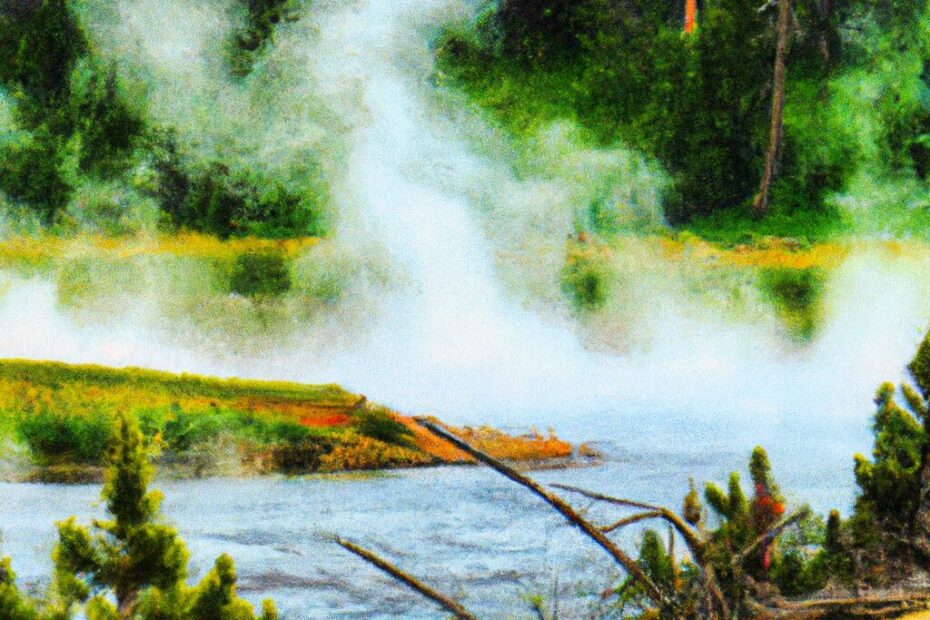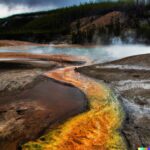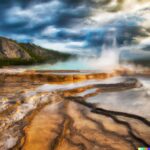Are you looking for a unique and unforgettable travel experience? Look no further than the Yellowstone Geysers! In this article, we will explore what makes Yellowstone Geysers so special, the best times to visit, and practical tips for planning your trip.
From must-see geysers to recommended hiking trails, we’ve got you covered. Plus, we’ll share essential packing tips and advice on how to stay safe and respectful during your visit. Get ready for an adventure like no other at Yellowstone Geysers!
Why Visit Yellowstone Geysers?
Planning a trip to Yellowstone National Park to explore its mesmerizing geysers is a must for nature lovers and adventure seekers alike.
- The geothermal wonders of Yellowstone, including its world-famous geysers like Old Faithful and Grand Prismatic Spring, provide an unparalleled experience of nature’s power and beauty. Watching these majestic geysers erupt in a spectacular display of steam and water is truly awe-inspiring.
- To make the most of your visit, be sure to check the predicted eruption times for the geysers, as each one operates on its unique schedule. Remember to stay on designated pathways and boardwalks to ensure your safety and protect the delicate ecosystem surrounding these geothermal features.
What Makes Yellowstone Geysers Unique?
Yellowstone National Park’s geysers captivate visitors with their spectacular geothermal displays and unique natural phenomena.
These geysers, such as the famous Old Faithful and the mesmerizing Grand Prismatic Spring, are not only visually stunning but also hold significant geological importance. The park’s thermal pools, shaped by the underground heat of the supervolcano beneath, offer a glimpse into the Earth’s powerful forces at work.
Witnessing the rhythmic eruptions of these geysers and marveling at the vibrant colors of the hot springs make for an unforgettable experience, drawing in tourists from all corners of the globe to admire the scenic beauty of Yellowstone’s geothermal wonders.
What Are The Best Times To Visit Yellowstone Geysers?
Timing your visit to Yellowstone’s geysers is crucial to enjoy optimal weather conditions, wildlife sightings, and geothermal spectacles.
Visiting Yellowstone National Park during the spring and fall seasons is recommended for geyser exploration. In the spring, you can witness the park coming back to life with vibrant blooms, and the wildlife is more active after the winter. Fall offers stunning foliage colors, fewer crowds, and beautiful crisp weather. These seasons provide an ideal balance for comfortable exploration while avoiding extreme temperatures. Planning your visit for early mornings or late afternoons increases your chances of witnessing remarkable geyser eruptions in the perfect lighting conditions.
Planning Your Trip to Yellowstone Geysers
Creating a comprehensive plan for your Yellowstone geysers excursion involves arranging accommodations, transportation, and crafting an exciting itinerary.
Selecting accommodations near the geysers can enhance the authenticity of your experience, allowing you to witness these natural wonders up close. Opting for lodges within the park not only offers convenience but also immerses you in the pristine surroundings. Efficient transportation options, such as shuttle services or organized tours, make navigating the vast park much easier.
Constructing a well-structured itinerary is key to fully explore the geysers, ensuring you don’t miss iconic attractions like Old Faithful or Grand Prismatic Spring.
What Is The Best Way To Get To Yellowstone Geysers?
Choosing the optimal transportation method to reach Yellowstone’s geysers ensures a seamless journey and adds to the adventure of your road trip.
For those embarking on a road trip to Yellowstone, the park offers a variety of travel routes that cater to different preferences and needs. From the iconic Grand Loop Road that takes you past stunning vistas and waterfalls to the scenic Beartooth Highway offering panoramic views, there is a route for every type of traveler.
Keep in mind any potential road closures due to weather conditions, especially during the winter months when some roads may be inaccessible. Planning ahead and staying updated on road conditions will help you navigate the park efficiently and make the most of your visit.
Where To Stay Near Yellowstone Geysers?
Choosing the right accommodations near Yellowstone’s geysers ensures a comfortable stay amidst the park’s natural wonders, with options ranging from cozy lodges to family-friendly camping sites.
The lodges near Yellowstone’s geysers offer a blend of rustic charm and modern amenities, providing a cozy retreat after a day of exploring. With comfortable beds and well-appointed rooms, lodges cater to travelers seeking a more upscale experience.
On the other hand, camping sites bring you closer to nature, allowing for a unique outdoor experience under the starry skies of Yellowstone. These family-friendly accommodations are perfect for those looking to immerse themselves in the park’s unparalleled beauty while enjoying the camaraderie of fellow campers.
What Are The Must-See Geysers In Yellowstone?
Exploring the iconic geysers of Yellowstone, such as the legendary Old Faithful and the vibrant Grand Prismatic Spring, is an unforgettable experience that showcases the park’s natural beauty.
Witnessing the eruption of Old Faithful, which spouts boiling water up to 180 feet in the air at regular intervals, is a mesmerizing sight that draws crowds from around the globe.
The Grand Prismatic Spring, with its striking rainbow hues caused by thermophilic bacteria, offers a surreal contrast against the park’s lush greenery. These geysers not only captivate visitors with their natural spectacle but hold cultural significance for the tribes who consider Yellowstone a sacred land, adding layers of historic depth to their allure.
What Are The Best Hiking Trails Near Yellowstone Geysers?
Immerse yourself in Yellowstone’s natural wonders by exploring the best hiking trails near the geysers, offering outdoor enthusiasts and nature lovers a chance to connect with the park’s diverse landscapes.
Traversing through these hiking paths near the geysers provides a thrilling mix of adventure and serenity, where hikers can witness the bubbling hot springs, vibrant geothermal pools, and awe-inspiring geysers along the way. The trails vary in difficulty to cater to all levels of hikers, from gentle strolls amidst colorful wildflowers to challenging treks up steep slopes offering breathtaking panoramic views of the park’s unique beauty.
Walking through Yellowstone’s tranquil forests and open meadows, visitors can spot an array of wildlife, from grazing bison to elusive bears, adding to the immersive experience of being surrounded by nature’s grandeur.
What To Pack For Your Yellowstone Geysers Trip
Preparing the right essentials for your Yellowstone geysers trip, including hiking gear, photography equipment, and safety items, ensures a smooth and enjoyable outdoor experience.
When heading out for a Yellowstone adventure, it’s crucial to pack durable and comfortable hiking boots to tackle the varied terrain. Opt for moisture-wicking clothing to stay dry and warm, especially during unpredictable weather conditions. A sturdy backpack to carry water, snacks, and essential gear is a must-have. Don’t forget to bring a high-quality camera or smartphone for capturing the breathtaking landscapes and wildlife encounters. Include essential safety items like a first-aid kit, emergency whistle, navigation tools, and bear spray to navigate the park’s wilderness confidently.
Essential Items To Bring
Your Yellowstone adventure necessitates packing essential items such as water bottles, snacks, sunscreen, and a first aid kit to ensure you are prepared for a day of exploration in the national park.
- It’s important to include sturdy hiking shoes to navigate the diverse terrain comfortably.
- Pack lightweight and quick-dry clothing for changing weather conditions.
- A camera or smartphone to capture stunning landscapes and wildlife encounters is a must.
- Don’t forget to carry a reusable bag for any trash you generate, respecting the park’s leave-no-trace principles.
- Include a trail map or GPS device to stay on course during hikes and ensure a safe and enriching wilderness experience.
Recommended Clothing For Different Seasons
Adapting your clothing choices to Yellowstone’s varying seasons is essential for comfort and safety during your trip, requiring versatile travel gear to accommodate changing weather conditions.
- Layering is key when preparing for Yellowstone’s dynamic climate, as temperatures can fluctuate drastically throughout the day. Start with moisture-wicking base layers to regulate body temperature, add insulating mid-layers for warmth, and top it off with a waterproof and windproof outer shell to shield against rain and snow.
- Investing in sturdy hiking boots with good traction is crucial for navigating the park’s rugged terrain, while packing a lightweight yet durable backpack ensures you have essentials like water, snacks, and a first aid kit easily accessible during your outdoor adventures.
Tips For A Safe And Enjoyable Trip To Yellowstone Geysers
Ensuring a safe and enjoyable experience at Yellowstone’s geysers involves following essential safety tips, respecting wildlife habitats, and embracing responsible exploring practices.
When observing wildlife, it’s crucial to maintain a safe distance and not approach too closely. Remember that these animals are wild and unpredictable, and your safety and theirs depend on respecting their space.
When exploring the geothermal areas, always stay on designated paths and boardwalks to avoid accidental burns or damage to fragile ecosystems.
Taking care to pack out all trash and leave no trace helps preserve the park’s pristine beauty for future visitors to enjoy.
By following these guidelines, you can contribute to a safer, more sustainable experience at Yellowstone National Park.
How To Stay Safe Around Geysers
Navigating the geothermal wonders of Yellowstone safely involves understanding geyser behavior, adhering to designated paths, and respecting the volatile nature of these thermal features.
When visiting Yellowstone, one must remember that geysers are unpredictable natural phenomena that can erupt scalding water and steam at any moment. By staying on designated paths, visitors not only protect themselves from potential harm but also safeguard the delicate thermal ecosystem. It is crucial to maintain a safe distance from geothermal features, as the crust around them can be thin and fragile. Following safety guidelines such as heeding warning signs and staying alert can significantly reduce the risks associated with exploring Yellowstone’s geysers.
How To Respect The Environment While Visiting Yellowstone Geysers
Preserving the natural beauty of Yellowstone’s geysers requires responsible exploring practices, environmental awareness, and a commitment to conserving the park’s pristine landscapes for future generations.
By showing respect for the delicate ecosystem of the park, visitors can play a crucial role in maintaining its ecological balance. Embracing sustainable tourism practices not only minimizes negative impacts on wildlife and flora but also contributes to the overall health of the environment. Encouraging others to follow guidelines for minimizing waste, staying on designated trails, and avoiding disturbance to wildlife habitats can help create a more harmonious coexistence between humans and nature within Yellowstone National Park.
Last Updated on February 7, 2024 by Jon Waraas – Originally Posted: February 7, 2024

I’m Jon Waraas, and I’ve been navigating the online world since 2006. By day, I’m the proud owner of some eCommerce gems, and by night, I’m the voice behind the adventures on Waraas.Com.
My heart, however, belongs to the wild beauty of Yellowstone National Park. I’ve got a collection of websites dedicated to sharing the wonders of this natural masterpiece. Oh, and did I mention? I’m currently building my own cabin inside the ghost town of Gilmore, Idaho – a cabin with tales to tell!
When I’m not immersed in the digital realm, you’ll find me lacing up my boots for a good hike or setting up camp under the star-studded sky.




